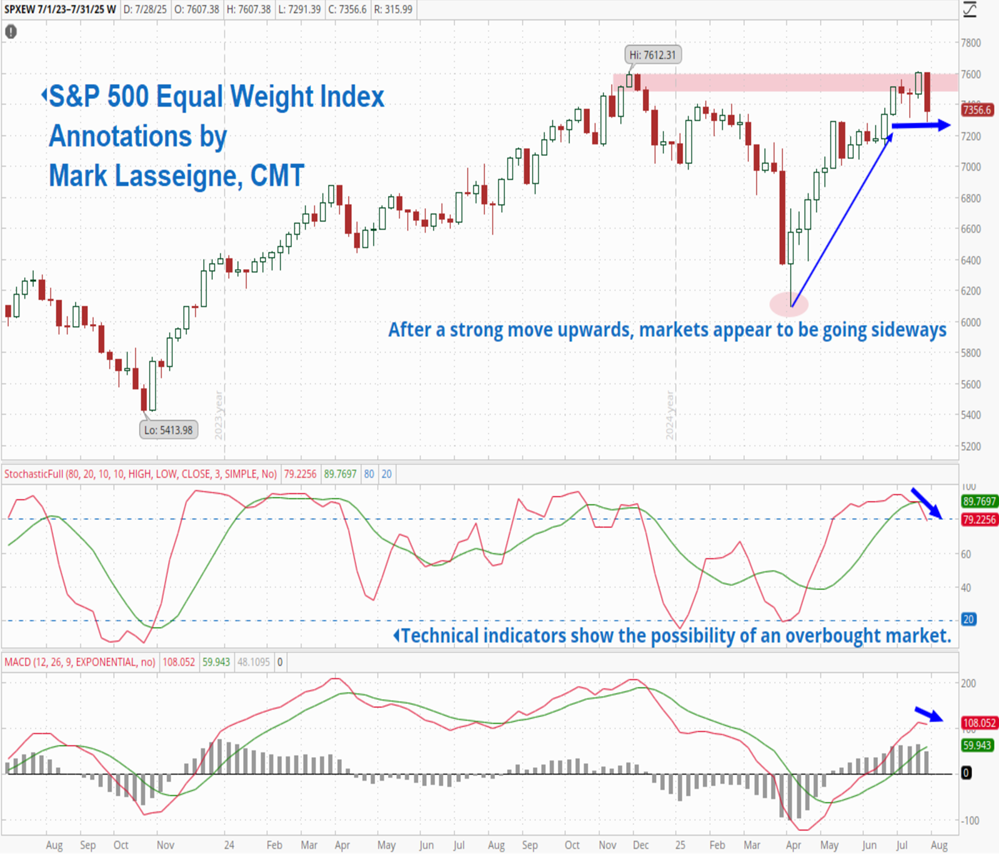Mark on the Markets
August 2025
New Market Highs… Cautious Optimism
Amid an onslaught of anxieties over tariffs, the economy, and geopolitical challenges in the Middle East, investors brushed aside worries and drove the S&P 500 Index and the Nasdaq Composite to record closing highs on the final two trading days of June, according to data provided by MarketWatch.
A sharp selloff in early April pulled the S&P 500 down 18.9% from its February 19 high, taking the index within just over one percentage point of officially entering bear market territory.

But a 90-day delay in the president’s reciprocal tariffs, a steady economy, stable interest rates, AI-driven momentum, and a buy-the-dip mentality have offset lingering economic and geopolitical fears.
Although trade agreements often require years of negotiation, the optimism among investors on trade and the possibility of progress has also boosted overall sentiment.
Notably, the hostilities between Israel and Iran had only a limited and short-term effect on stocks and oil. Historically, geopolitical turmoil has not significantly impacted U.S. markets, according to data from LPL Research.
Practically speaking, it boils down to whether trouble overseas will affect the U.S. economy. For example, the OPEC oil embargo in the early 1970s exacerbated inflation and contributed to the 1974 recession. And with it, stocks landed in a bear market.
In June, however, Israel’s attack on Iran produced dramatic headlines but had virtually no impact on U.S. economic activity. While tensions are simmering, the swift resolution eliminated a potential headwind.
The Long View
The swift decline in stocks and subsequent recovery are a stark reminder that successful investors play the long game and avoid timing market volatility.
We recognize the importance of risk management, and your level of risk tolerance influences the suggestions we provide. However, your financial strategy incorporates unforeseen setbacks—the unpredictable market downturns—that are likely to occur as you work towards your financial objectives.
It may seem like a cliché (and it is), but an old adage deserves to be repeated: “Time in the market, not timing the market,” is the not-so-secret sauce that plays a key role in building wealth.
Patience is a virtue. It’s often the quiet strength behind the most meaningful successes. We see it in the data. Historically, U.S. equities have overcome difficult periods, eclipsing their former highs following a setback.
As we wrap up, let’s look at one dataset. Bespoke reports that the likelihood of the S&P 500 finishing higher on any single day is just 53% (since 1928). Such odds are slightly higher than a coin toss.
Yet, when examining all one-month intervals going back to 1928, the probability of the S&P 500 closing higher after one month increases to 63%. For one-year periods, the index has risen 75% of the time. This figure jumps to 95% over a decade.
Although past performance does not ensure future outcomes, the U.S. stock market has a remarkable long-term track record, and our investing philosophy aims to leverage the positive trend. In short, patience and the long game have rewarded investors.
Key Market and Economic Drivers
- The S&P 500 gained 2.2% in July, the Dow Jones Industrial Average was up 0.1%, and the Nasdaq rose 3.7%. Year-to-date, the S&P 500 is up 7.8%, the Dow is up 3.7%, and the Nasdaq is up 9.4%.
- The Bloomberg U.S. Aggregate Bond Index declined 0.3% in July. The 10-year Treasury yield rose slightly to end the month at 4.38%.
- International stocks were mixed with the MSCI EAFE index of developed markets declining 1.5% and the MSCI EM index of emerging markets gaining 1.7%.
- GDP grew at an annualized rate of 3.0% in the second quarter, due largely to a reversal in business investment and import activity due to tariffs.
- The U.S. dollar index rebounded somewhat from 96.88 at the end of June to 99.97 at the end of July. It is still down significantly this year.
- The price of gold remained strong but sits below its recent peak, ending the month at $3,293.
- Copper surged to record levels due to targeted tariffs, but then experienced its largest single-day drop of 22%.
- The Consumer Price Index rose 2.7% on a year-over-year basis in June, in line with economist expectations.
- The economy added only 73,000 jobs in July. Significant downward revisions to the May and June figures mean that the economy was much weaker than originally reported. The unemployment rate remained low at 4.2%.
Mark on the Charts
Like the old Timex watch commercial, the U.S. stock market continues to march higher as the economy continues to “take a licking but keep on ticking!” The S&P 500 Equal Weighted Index chart shows this, after dropping in April, the market regained the highs set in November and December of last year. However, the momentum seems to be waning as the market digests the gains. The two-year weekly chart below is market with the uptrend in blue, and then the sideways market we have seen for the past couple of weeks. The white bars showing when the market moves up, and the red bars showing when the market moves down. The longer the bars, the stronger the movement was for the week.
As I mentioned last month, the market has been active this summer. The interest rate cut investors were hoping for in July did not materialize. A September rate cut could give this market more energy upward, however, tariff uncertainty and geopolitical tensions could change the dynamics quickly.

Timely Tax Tidbits
A New Charitable Contribution Deduction in the “One Big Beautiful Bill” Take Advantage of It, But It Doesn’t Start Until 2026
There is a $2,000 charitable contribution deduction for married couples. It’s a new above-the-line deduction introduced under the "One Big Beautiful Bill" Act. This provision reinstates and expands a universal charitable deduction that was temporarily available during the COVID-19 era (up to $300 for individuals and $600 for married filing jointly in 2020-2021) but had expired.

Starting in 2026, if you are married and file jointly, and donate $2,000 to charity, you can take the standard deduction and the deduction for your $2,000 donation to a qualified charity. Single filers can deduct up to $1,000.
If you itemize instead, you fall under traditional charitable deduction rules: up to 60% of AGI for cash contributions to public charities (temporarily increased from 50% under prior law), with carryover allowed for excess amounts over 5 years. Lower limits (20-30% of AGI) apply to non-cash gifts or donations to certain private foundations.
This deduction does not affect qualified charitable distributions (QCDs) from IRAs, which allow those age 70½ or older to donate up to $105,000 (indexed for inflation in 2025) tax-free from their IRA.
You must keep records of all contributions, such as bank statements or receipts. For donations of $250 or more, obtain a written acknowledgment from the charity detailing the amount and confirming no goods/services were received in return. Report the deduction on Form 1040, likely as an adjustment to income (like education expenses or student loan interest).
Tax savings: For a married couple in the 22% tax bracket donating $2,000, this could save up to $440 in federal taxes, depending on your overall situation.
Strategic Tip: With the change effective in 2026, 2025 may be a good year to "bunch" larger donations if you itemize or consider donor-advised funds to time gifts.
Note: This is a federal deduction; state tax rules may vary, and the OBBB Act includes other changes like capping itemized charitable deduction benefits at 35% for high earners.
For specific guidance, consult a tax professional, as details could be clarified in upcoming regulations.

Tech Support Scams Are on the Rise
In early 2021, Marjorie Bloom, a 77-year-old retired federal attorney, fell victim to a complex tech support scam that cost her $661,000. In summary, the scammer pretended to be a “fraud investigator” from PNC Bank, where Ms. Bloom had been a long-standing customer.
How could such a fraudulent activity occur? According to CNBC, the “investigator” persuaded her that criminals—using stolen personal data—were in the process of pilfering her life savings.
To protect her money, he said, she needed to take preventative action and move her funds quickly and covertly.
Divulging the problem to anyone, especially to her three children, could thwart the “bank’s” efforts to protect her life savings, he said.
How was she contacted? An unsolicited popup window on her PC alerted her to call a customer support phone number listed on the screen, supposedly for Microsoft.
Let’s be clear: Legitimate tech companies never do this. Let me repeat that. Legitimate tech companies never do this.
How did she receive the popup message? Possibly, she was simply surfing the web when a site that had been infected with a malicious code launched the popup and the phone number that led to criminals.
Unfortunately, she called the number, and the “engineer” informed her she had been hacked. She volunteered her information that she banked at PNC, and he transferred her to a scammer posing as a PNC fraud investigator.
It’s heartbreaking to relay such a story, but do you see some of the red flags? It’s easy in hindsight.
- Don’t tell anyone.
- You must move quickly.
- It was an unsolicited popup on her computer.
What’s more concerning is that if a legitimate bank employee raises red flags about unusual transactions, scammers are often ready with convincing scripts to coach you through the interaction, making it harder for legitimate fraud teams to intervene and protect you.
Scammers are slick, smooth, and ruthless.
According to Microsoft, tech support scams are an industry-wide issue where scammers use scare tactics to trick you into unnecessary technical support services that supposedly fix your device or remedy software problems that don’t exist.
Tech support scams are on the rise and often start with a popup message or a sudden phone call claiming there’s a problem with your computer or device.
The goal is to get you to pay for fake repair services or grant remote access to your device. Once inside, scammers can install harmful software that puts your personal and financial information at risk.
Furthermore, ignore popup warnings with phone numbers and keep your software updated.
The best defense is awareness. If you ever receive a suspicious message or call, don’t respond or click any links. Instead, contact the company directly using a number from their official website—not one from a popup or email—or reach out directly to a trusted source, such as your IT professional or a family member or friend.
What if You are a victim?
Report the crime at https://www.ic3.gov/. The Internet Crime Complaint Center (IC3) is the central hub for reporting cyber-enabled crime. It is run by the FBI.
What if you paid a scammer? The Federal Trade Commission encourages you to contact the company or bank that issued the credit or debit card. Inform them it was a fraudulent charge.
Fraudulent wire transfers could be reversed if you act quickly.
Cryptocurrency payments are not reversible. Any company that insists on payment in cryptocurrency should immediately raise serious concerns, as it is often a hallmark of fraudulent activity.
You can report the fraud at https://reportfraud.ftc.gov/.
Bottom Line
Scammers are growing increasingly sophisticated; they show no mercy and often target older adults with deceptive and convincing tactics.
But with the right mix of knowledge, caution, and common sense, you can greatly reduce your risk of fraud.

We’re committed to helping you experience financial contentment and peace through a plan that’s right for you, and by aligning your investment with your Christian values. It’s about understanding how you want to live and what you want to do. Whether you want to spend time with family or volunteer to make the world a better place, we help you prepare to spend your time, talents, and resources on what matters most to you.
Implementing faith-based investing begins just like any other investment
management process – we’re looking for great investments!
I hope you’ve found this review to be educational and helpful. Our goal is to be a guide to you as you run the race and keep the faith.
Give, and it will be given to you; good measure, pressed down, shaken together, running over, will be put into your lap. For the measure you give will be the measure you get back.” Luke 6:38
Contact Us for a Free Consultation


